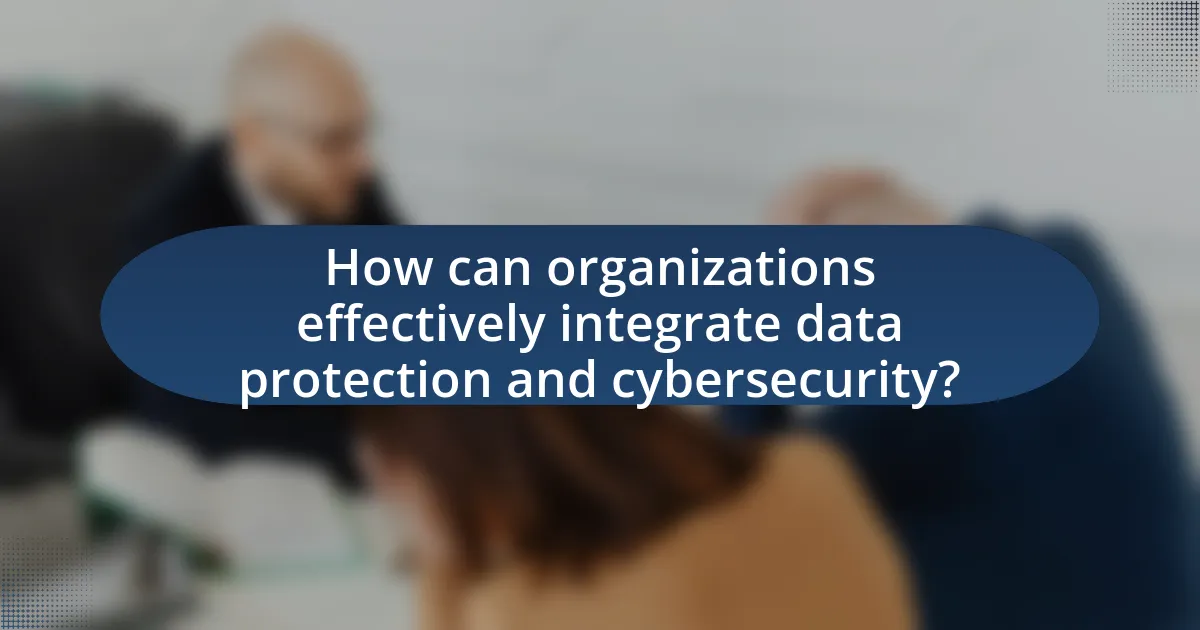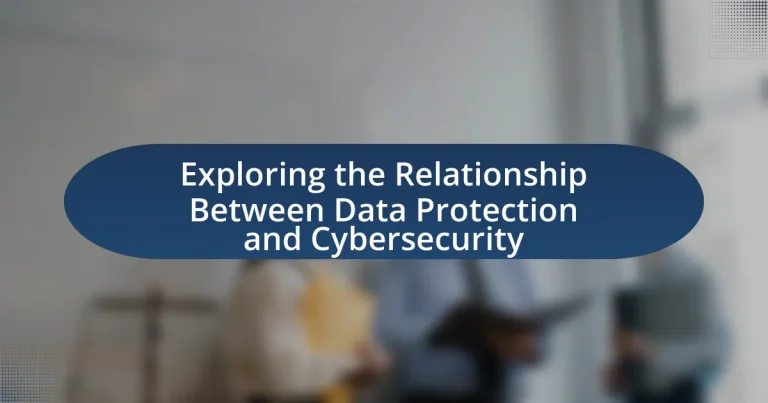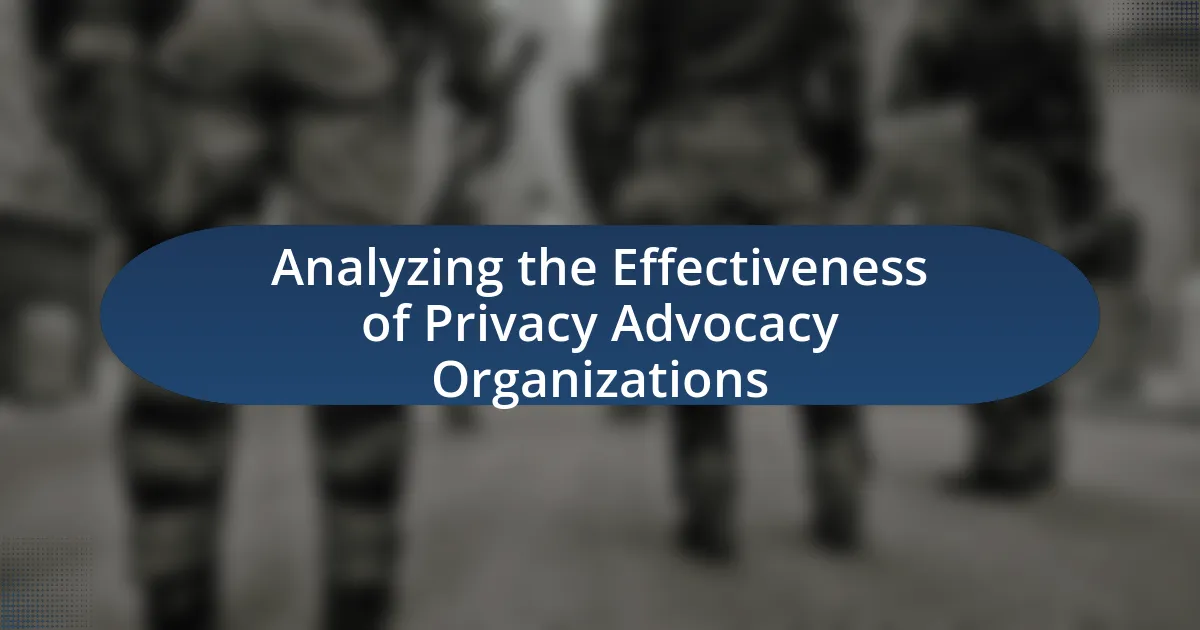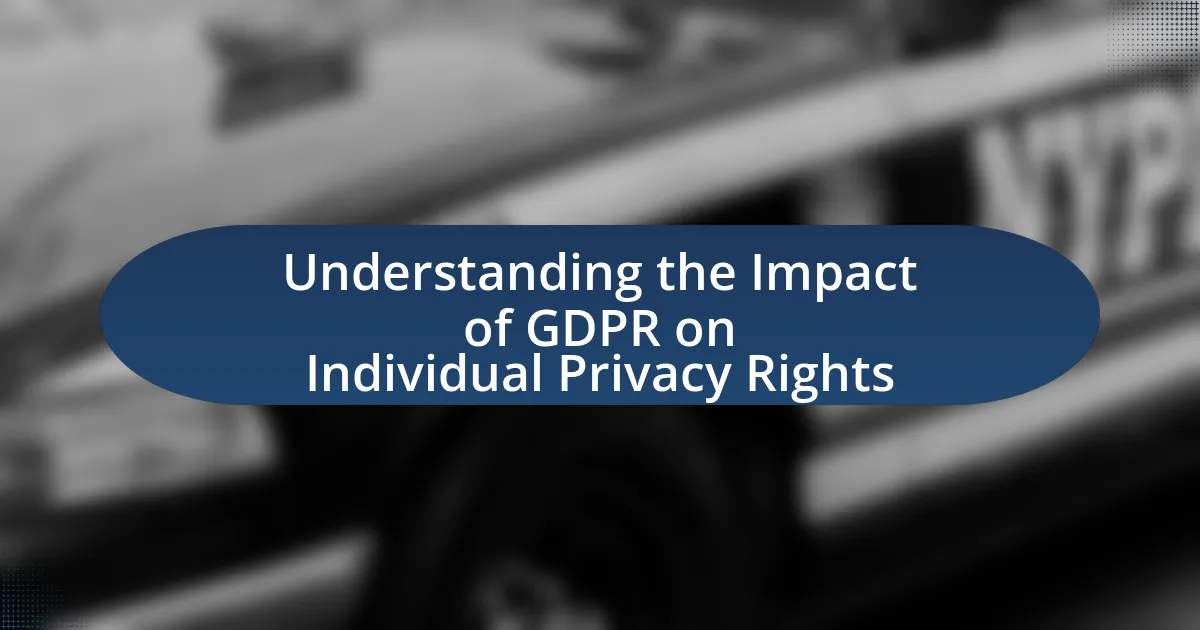The article explores the intricate relationship between data protection and cybersecurity, emphasizing their collaborative role in safeguarding sensitive information. It outlines how data protection focuses on policies ensuring privacy and integrity, while cybersecurity employs technologies to defend against cyber threats. Key principles of data protection, such as lawfulness and accountability, are discussed alongside essential cybersecurity strategies, including encryption and access controls. The article highlights the importance of integrating both disciplines to mitigate risks, comply with regulations like GDPR, and enhance overall security posture, while also addressing common challenges organizations face in this integration process.

What is the relationship between data protection and cybersecurity?
Data protection and cybersecurity are closely related concepts that work together to safeguard sensitive information. Data protection focuses on the policies and practices that ensure the privacy and integrity of personal and sensitive data, while cybersecurity involves the technologies and measures that protect systems and networks from cyber threats. For instance, regulations like the General Data Protection Regulation (GDPR) mandate organizations to implement robust cybersecurity measures to protect personal data from breaches, thereby linking data protection directly to cybersecurity practices.
How do data protection and cybersecurity intersect?
Data protection and cybersecurity intersect primarily through their shared goal of safeguarding sensitive information from unauthorized access and breaches. Data protection focuses on the policies and practices that ensure the privacy and integrity of personal data, while cybersecurity encompasses the technologies and measures that protect systems and networks from cyber threats. For instance, regulations like the General Data Protection Regulation (GDPR) mandate organizations to implement robust cybersecurity measures to protect personal data, thereby linking compliance with data protection to effective cybersecurity practices. This intersection highlights the necessity for organizations to integrate both disciplines to mitigate risks and ensure comprehensive protection of data assets.
What are the key principles of data protection?
The key principles of data protection include lawfulness, fairness, and transparency; purpose limitation; data minimization; accuracy; storage limitation; integrity and confidentiality; and accountability. These principles are established under regulations such as the General Data Protection Regulation (GDPR), which mandates that personal data must be processed legally and transparently, collected for specified purposes, limited to what is necessary, kept accurate, retained only as long as necessary, secured against unauthorized access, and that organizations must demonstrate compliance. Each principle serves to protect individuals’ privacy and ensure responsible handling of personal data.
How does cybersecurity support data protection efforts?
Cybersecurity supports data protection efforts by implementing measures that safeguard sensitive information from unauthorized access and breaches. These measures include encryption, which secures data by converting it into a coded format that can only be read by authorized users, and firewalls, which act as barriers to prevent unauthorized access to networks. According to the 2021 Verizon Data Breach Investigations Report, 85% of data breaches involved a human element, highlighting the importance of cybersecurity training and awareness programs in protecting data. By addressing vulnerabilities and enhancing security protocols, cybersecurity plays a critical role in maintaining the integrity, confidentiality, and availability of data.
Why is understanding this relationship important?
Understanding the relationship between data protection and cybersecurity is crucial because it directly impacts the effectiveness of safeguarding sensitive information. Data protection measures, such as encryption and access controls, are essential for preventing unauthorized access and breaches, while cybersecurity strategies focus on defending against attacks and vulnerabilities. The interdependence of these two areas means that a failure in one can compromise the other; for instance, inadequate data protection can lead to successful cyberattacks, resulting in data loss or theft. According to the 2021 Verizon Data Breach Investigations Report, 61% of data breaches involved compromised credentials, highlighting the need for robust data protection practices alongside cybersecurity efforts to mitigate risks effectively.
What risks arise from neglecting data protection in cybersecurity?
Neglecting data protection in cybersecurity leads to significant risks, including data breaches, financial loss, and reputational damage. Data breaches can expose sensitive information, resulting in unauthorized access and exploitation of personal or corporate data. According to the 2021 IBM Cost of a Data Breach Report, the average cost of a data breach was $4.24 million, highlighting the financial implications of inadequate data protection. Additionally, organizations may face legal consequences due to non-compliance with data protection regulations, such as the General Data Protection Regulation (GDPR), which can impose fines up to €20 million or 4% of annual global turnover. Reputational damage can also occur, as customers and partners may lose trust in organizations that fail to protect their data, leading to long-term impacts on business relationships and market position.
How can organizations benefit from integrating data protection and cybersecurity?
Organizations can benefit from integrating data protection and cybersecurity by enhancing their overall security posture and reducing the risk of data breaches. This integration allows for a comprehensive approach to safeguarding sensitive information, ensuring compliance with regulations such as GDPR and HIPAA, which can lead to significant financial savings by avoiding penalties. According to a report by IBM, the average cost of a data breach in 2023 was $4.45 million, highlighting the financial implications of inadequate data security measures. Furthermore, organizations that adopt a unified strategy for data protection and cybersecurity can improve their incident response capabilities, leading to quicker recovery times and minimized operational disruptions. This synergy not only protects organizational assets but also builds customer trust, as clients are more likely to engage with businesses that demonstrate a commitment to safeguarding their data.

What are the main components of data protection and cybersecurity?
The main components of data protection and cybersecurity include data encryption, access controls, network security, incident response, and compliance with regulations. Data encryption protects sensitive information by converting it into a secure format that can only be read by authorized users. Access controls ensure that only authorized personnel can access specific data, reducing the risk of unauthorized access. Network security involves measures to protect the integrity and usability of networks and data, including firewalls and intrusion detection systems. Incident response refers to the processes and procedures for identifying, managing, and mitigating security breaches. Compliance with regulations, such as GDPR and HIPAA, ensures that organizations adhere to legal standards for data protection and privacy. These components collectively enhance the security posture of organizations and safeguard sensitive information from threats.
What are the different types of data protection measures?
Data protection measures can be categorized into several types, including encryption, access controls, data masking, backup solutions, and data loss prevention (DLP) technologies. Encryption secures data by converting it into a coded format, making it unreadable without the appropriate decryption key. Access controls restrict data access to authorized users only, ensuring that sensitive information is not exposed to unauthorized individuals. Data masking involves obscuring specific data within a database to protect it from unauthorized access while maintaining its usability for testing or analysis. Backup solutions create copies of data to prevent loss due to accidental deletion, corruption, or cyberattacks, while DLP technologies monitor and control data transfers to prevent unauthorized sharing or leakage of sensitive information. These measures collectively enhance data security and mitigate risks associated with data breaches and cyber threats.
How do encryption and access controls enhance data protection?
Encryption and access controls significantly enhance data protection by ensuring that sensitive information is both secured from unauthorized access and only accessible to authorized users. Encryption transforms data into a format that is unreadable without a decryption key, effectively safeguarding it from interception during transmission or unauthorized access in storage. For instance, the use of Advanced Encryption Standard (AES) can protect data at rest and in transit, making it nearly impossible for attackers to decipher without the appropriate key.
Access controls, on the other hand, regulate who can view or use resources in a computing environment. By implementing role-based access control (RBAC), organizations can limit access to sensitive data based on user roles, ensuring that only individuals with the necessary permissions can access specific information. According to a study by the Ponemon Institute, organizations that implement strong access controls can reduce the risk of data breaches by up to 50%. Together, encryption and access controls create a robust framework for data protection, mitigating risks associated with data breaches and unauthorized access.
What role do data backup and recovery play in data protection?
Data backup and recovery are essential components of data protection, as they ensure the preservation and restoration of critical information in the event of data loss. Effective data backup strategies create copies of data that can be retrieved after incidents such as cyberattacks, hardware failures, or accidental deletions. According to a study by the Ponemon Institute, 60% of small businesses that experience data loss close within six months, highlighting the importance of having reliable backup and recovery systems in place. These systems not only mitigate the risks associated with data breaches but also support compliance with regulatory requirements for data retention and protection.
What cybersecurity strategies are essential for data protection?
Essential cybersecurity strategies for data protection include implementing strong access controls, utilizing encryption, conducting regular security audits, and providing employee training on security awareness. Access controls ensure that only authorized personnel can access sensitive data, reducing the risk of unauthorized access. Encryption protects data both at rest and in transit, making it unreadable to unauthorized users. Regular security audits help identify vulnerabilities and ensure compliance with security policies. Employee training raises awareness about phishing attacks and other security threats, fostering a culture of security within the organization. These strategies collectively enhance data protection by mitigating risks associated with cyber threats.
How do firewalls and intrusion detection systems contribute to cybersecurity?
Firewalls and intrusion detection systems (IDS) are critical components of cybersecurity as they protect networks from unauthorized access and detect potential threats. Firewalls act as barriers between trusted internal networks and untrusted external networks, filtering incoming and outgoing traffic based on predetermined security rules. This filtering process prevents malicious traffic from entering the network, thereby reducing the risk of data breaches.
Intrusion detection systems complement firewalls by monitoring network traffic for suspicious activity and policy violations. When an IDS identifies a potential threat, it generates alerts for security personnel to investigate, enabling a proactive response to potential breaches. According to a report by the Ponemon Institute, organizations that implement both firewalls and IDS can reduce the average cost of a data breach by approximately 30%. This statistic underscores the effectiveness of these systems in enhancing overall cybersecurity posture.
What is the importance of employee training in cybersecurity?
Employee training in cybersecurity is crucial because it equips staff with the knowledge and skills necessary to recognize and respond to cyber threats effectively. A well-trained workforce can significantly reduce the risk of security breaches, as employees are often the first line of defense against phishing attacks, malware, and other cyber threats. According to a report by IBM, organizations that invest in comprehensive security awareness training can reduce the likelihood of a data breach by up to 70%. This statistic underscores the importance of ongoing education and training in fostering a security-conscious culture within an organization, ultimately protecting sensitive data and maintaining compliance with regulatory standards.

How can organizations effectively integrate data protection and cybersecurity?
Organizations can effectively integrate data protection and cybersecurity by implementing a unified framework that aligns both disciplines under a comprehensive risk management strategy. This approach involves establishing clear policies that govern data handling and security protocols, ensuring that all employees are trained on best practices for data protection and cybersecurity measures. For instance, the National Institute of Standards and Technology (NIST) Cybersecurity Framework emphasizes the importance of identifying, protecting, detecting, responding, and recovering from cybersecurity incidents, which can be directly applied to data protection efforts. By regularly conducting risk assessments and audits, organizations can identify vulnerabilities and ensure compliance with regulations such as the General Data Protection Regulation (GDPR), which mandates strict data protection measures. This integration not only enhances the overall security posture but also fosters a culture of accountability and awareness regarding data privacy and cybersecurity risks.
What best practices should organizations follow for integration?
Organizations should follow best practices such as establishing clear integration strategies, ensuring data consistency, and implementing robust security measures. Clear integration strategies involve defining objectives and aligning technology with business goals, which enhances operational efficiency. Ensuring data consistency requires regular data validation and synchronization processes to maintain accuracy across systems. Implementing robust security measures, including encryption and access controls, protects sensitive information during integration, thereby reducing the risk of data breaches. These practices are essential for maintaining data integrity and security, which are critical components in the relationship between data protection and cybersecurity.
How can risk assessments improve the integration process?
Risk assessments can improve the integration process by identifying potential vulnerabilities and threats within systems, allowing organizations to implement targeted security measures. By systematically evaluating risks, organizations can prioritize their resources and efforts on the most critical areas, thereby enhancing overall data protection and cybersecurity. For instance, a study by the National Institute of Standards and Technology (NIST) emphasizes that risk assessments help organizations understand their security posture and make informed decisions about integrating new technologies while maintaining compliance with data protection regulations. This proactive approach not only mitigates risks but also fosters a culture of security awareness during the integration process.
What frameworks can guide organizations in aligning data protection with cybersecurity?
Organizations can utilize frameworks such as the NIST Cybersecurity Framework, ISO/IEC 27001, and the GDPR to align data protection with cybersecurity. The NIST Cybersecurity Framework provides a comprehensive approach to managing cybersecurity risks, emphasizing the importance of protecting sensitive data. ISO/IEC 27001 offers a systematic approach to managing sensitive information, ensuring that data protection measures are integrated into the overall cybersecurity strategy. The GDPR sets strict guidelines for data protection, compelling organizations to implement robust cybersecurity measures to safeguard personal data. These frameworks collectively guide organizations in establishing a cohesive strategy that addresses both data protection and cybersecurity effectively.
What common challenges do organizations face in this integration?
Organizations commonly face challenges such as data silos, regulatory compliance, and resource allocation in the integration of data protection and cybersecurity. Data silos occur when information is isolated within departments, hindering a unified security strategy. Regulatory compliance poses difficulties as organizations must navigate complex laws like GDPR and HIPAA, which require stringent data protection measures. Additionally, resource allocation challenges arise when organizations struggle to balance investments in cybersecurity tools and personnel with other operational needs, often leading to inadequate protection. These challenges are well-documented in industry reports, such as the 2022 Cybersecurity and Data Protection Survey by the International Association for Privacy Professionals, which highlights that 60% of organizations cite compliance as a significant barrier to effective integration.
How can organizations overcome resource limitations in data protection and cybersecurity?
Organizations can overcome resource limitations in data protection and cybersecurity by prioritizing risk assessment and implementing cost-effective solutions. By conducting thorough risk assessments, organizations can identify critical assets and vulnerabilities, allowing them to allocate resources more effectively. For instance, the National Institute of Standards and Technology (NIST) recommends a risk management framework that helps organizations focus on the most significant threats, ensuring that limited resources are directed where they are needed most. Additionally, leveraging cloud-based security services can provide scalable solutions without the need for extensive on-premises infrastructure, thus optimizing costs while enhancing security measures.
What are the implications of regulatory compliance on integration efforts?
Regulatory compliance significantly impacts integration efforts by imposing strict guidelines that organizations must follow during the integration of systems and processes. These guidelines often require organizations to implement specific security measures, data handling protocols, and reporting mechanisms, which can complicate and lengthen the integration process. For instance, compliance with the General Data Protection Regulation (GDPR) necessitates that organizations ensure data privacy and protection during system integration, leading to additional technical requirements and potential delays. Furthermore, failure to comply with these regulations can result in substantial fines and legal repercussions, thereby incentivizing organizations to prioritize compliance in their integration strategies.
What practical steps can organizations take to enhance their data protection and cybersecurity relationship?
Organizations can enhance their data protection and cybersecurity relationship by implementing a comprehensive risk assessment framework. This framework should identify vulnerabilities in both data protection and cybersecurity measures, allowing organizations to prioritize resources effectively. For instance, according to a 2021 report by the Ponemon Institute, organizations that conduct regular risk assessments experience 30% fewer data breaches compared to those that do not. Additionally, organizations should establish clear policies that integrate data protection protocols with cybersecurity strategies, ensuring that all employees are trained on these policies. Regular audits and updates to these policies, in line with evolving threats, further strengthen the relationship between data protection and cybersecurity.





